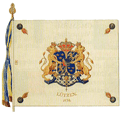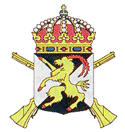

Copyright © Hans Högman 2019-05-20
Swedish Regiments of
the Allotment System -
Infantry (2)
Infantry Regiments:
1. Swedish Regiments -
Infantry (2)

Swedish name: Dalregementet,
I13
In English also known as the Dalecarlia
Regiment.
The regiment was first established in 1621 as the
Dal Regiment. The regiment was linked to the
Allotment System in 1621.
The regiment's history goes back to the "fänikor" that
were raised in the province of Dalarna in 1542. In the
1620's, King Gustav II Adolf formed a
"landsregemente" - a Grand Regiment, from "fänikor"
in the provinces of Dalarna, Uppland and
Västmanland. The Grand Regiment was later divided
into three independent regiments: The Dalecarlia
Regiment, the Uppland Regiment and the
Västmanland Regiment.
The conscript system (utskrivning) of recruiting
soldiers was a very hard burden on the people of
Dalecarlia (Dalarna). As early as 1621 the farmers of
Dalecarlia signed a contract with the Crown stating
that they would provide 1,400 soldiers to the Dal
Regiment. In return the farmers was exempted from
having to serve as a soldier.
As a result of the Constitution adopted in 1634 the
Army was reorganized. The Dal regiment was then
referred to as the "7th Regiment".
The regiment was allotted with 1,200 rotar.
Hence, the Regiment had 1,200 soldiers organized
into 8 companies. All of the "rotar" were located
within the province of Dalarna (Dalecarlia).
Names of the Companies making up the
Regiment in 1682: The Life Company, The
Lieutenant Colonel's Company, The Major's
Company, Orsa Company, Rättviks Company, Gagnef
Company, Mora Company and Västerdals Company.
Uniform before the standard uniform: Blue coat
with yellow cuffs and white scarfs (1679). The
regiment received the standard uniform (the blue
and yellow Carolean uniform) in 1690.
Location of the primary Garrison of the
Regiment: From 1908, Falun. Training camp: from
1676 Rommehed, Borlänge.
The Official Regimental Colors: Yellow and blue
See also: Campaigns of the Dal Regiment.
Companies 1854 :
1.
Life Company
2.
Leksand Company
3.
Gagnef Company
4.
Gustafs Company
5.
Vesterdas Company
6.
Orsa Company
7.
Mora Company
8.
Rättvis Company
Victorious Battle Campaigns (segernamn):
•
Lützen
1632
•
Leipzig
1642
•
Lund
1676
•
Landskrona
1677
•
Narva
1700
•
Düna
1701
•
Kliszow
1702
•
Holovczyn
1708
•
Malatitze
1708
•
Gadebusch
1712
Swedish name: Östgöta
infanteriregemente, I4
The regiment was first established in
1636 as the Östgöta Infantry
Regiment. The regiment was linked to the Allotment
System in 1685.
In 1791 the regiment was merged with the Östgöta
Cavalry Regiment and the infantry part of the
regiments received the name; The "rotehåll" division
of the Life Grenadier Regiment
(Livgrenadjärsregementets rotehållsdivision). The
cavalry regiment was then a dismounted regiment.
In 1816 the new regiment was divided and
reorganized into the two old regiments. The former
infantry regiment received the name the First Life
Grenadier Regiment (Första Livgrenadjärregementet,
I4) and the former cavalry regiment received the
name the Second Life Grenadier Regiment (Andra
Livgrenadjärregementet, I5).
The regiment was disestablished in 1927. This year
the two regiments once again were merged and
received the name Life Grenadier Regiment (I4).
The regiment's history goes back to the "fänikor" that
was raised in the province of Östergötland in the
16th century.
King Gustav II Adolf formed a "landsregemente" - a
Grand Regiment, from the "fänikor" in Östergötland
and from "fänikor" in the province of Småland
(County of Jönköping).
In 1623 the Grand Regiment was split up into two
independent regiments, The Jönköping Regiment and
the Östgöta Infantry Regiment.
As a result of the Constitution adopted in 1634 the
Army was reorganized. The Östgöta Regiment was
then referred to as the "8th Regiment".
The regiment was allotted with 1200 "rotar".
Hence, the Regiment had 1200 soldiers organized
into 8 companies. All of the "rotar" were located
within the province of Östergötland.
A grenadier was originally a soldier armed with hand
grenades. The grenadier first fired his musket and
then he would light the fuse of the grenade and
throw it. The next move was to charge the enemy
with the bayonet mounted on the musket. In each
company there were 12 grenadiers.
The grenadiers were the first to be equipped with
bayonets (beginning of the 18tn century). They were
also equipped with a kind of grenade rifles.
Later when the range of fire of the muskets
increased the role of the grenadier changed. In stead
the best grenadiers formed an elite unit.
The grenadiers wore a special hat.
See image to the right.
At the end of the 18th century the
grenadier units became ordinary
infantry units.
Names of the Companies making
up the Regiment in 1682: The Life Company, The
Lieutenant Colonel's Company, The Major's
Company, Ydre Company, Östanstångs Company,
Kinds Company, Västanstångs Company and
Vadstena Company.
Uniform before the standard uniform: Red coat
with black cuffs (1678). The regiment received the
standard uniform (the blue and yellow Carolean
uniform) in 1692.
Location of the primary Garrison of the
Regiment: From 1922, Linköping. Training camp:
From the 17th century Malmen, Linköping.
The Official Regimental Colors: White
Companies 1854:
1.
Life Company
2.
Stångebro Company
3.
Kinds Company
4.
Östanstångs Company
5.
Ombergs Company
6.
Vreta Klosters Company
7.
Motala Company
8.
Ydre Company
Victorious Battle Campaigns (segernamn):
•
Lützen
1632
•
Leipzig
1642
•
Helsingborg
1710
•
Gadebusch
1712
•
Walkiala
1790
Swedish name: Hälsinge
regemente, I14
The regiment was first established in
1630 as the Joakim Brahe's
Regiment. The name was changed to
the Hälsinge Regiment in 1634. The regiment was
linked to the Allotment System in September 9th
1682.
The regiment was disestablished in 1992.
Today a local defense district unit
(försvarsområdesförband) carry the same name.
The regiment's history goes back to the "fänikor" that
was raised in the provinces of Gästrikland and
Hälsingland in the 1550's. In 1552 there was a
Norrland fänika (Hälsingland is in the region of
Norrland) and in 1563 there was a Hälsninge fänika.
King Gustav II Adolf formed a "landsregemente" - a
Grand Regiment, from these "fänikor" in 1615. This
Grand Regiment was called The Norrland Grand
Regiment (Norrlands storregemente) and numbered
3000 soldiers.
In 1623 the Grand Regiment was divided into two
independent regiments, The Hälsinge Regiment and
The Västerbotten Regiment.
The Hälsinge Regiment's "rotar" were located in
southern Norrland and the Västerbotten Regiment's
"rotar" in northern Norrland. The "rotar" in the
provinces of Medelpad and Ångermanland (in mid
Norrland) belonged to the Västerbotten Regiment.
The Hälsinge Regiment was the second regiment to
be allotted after the Dalecarlia Regiment.
As a result of the Constitution adopted in 1634 the
Army was reorganized. The Hälsinge regiment was
then referred to as the "10th Regiment".
The regiment was allotted with 1200 "rotar".
Hence, the Regiment had 1200 soldiers organized
into 8 companies. All of the "rotar" were located
within the County of Gävleborg (300 in the province
of Gästrikland and 900 in the province of
Hälsingland).
Names of the Companies making up the
Regiment in 1682: The Life Company, The
Lieutenant Colonel's Company, The Major's
Company, Alsta Company, Delsbo Company, Ovansjö
Company, Arbrå Company and Jervsö Company.
Uniform before the standard uniform: Grey coat
with green cuffs (1675) and red coat with green cuffs
(1679). The regiment received the standard uniform
(the blue and yellow Carolean uniform) in 1694.
Location of the primary Garrison of the
Regiment: From 1909, Gävle. Training camp:
Between 1630 and 1689 Florhed and from 1689
Mohed, Söderhamn.
The Official Regimental Colors: Black and white
Companies 1854:
1.
Life Company
2.
Forssa Company
3.
Järvsö Company
4.
Delsbo Company
5.
Färnebo Company
6.
Arbrå Company
7.
Alfta Company
8.
Ovansjö Company
Victorious Battle Campaigns (segernamn):
•
Novgorod
1611
•
Warszawa
1656
•
Fredriksodde
1657
•
Tåget över Bält
1658
•
Lund
1676
•
Landskrona
1677
•
Narva
1700
•
Düna
1701
•
Jakobstadt
1704
•
Gemäuerthof
1705
•
Gadebusch
1712
Related Links
•
The Allotment System
•
Swedish Wars
•
The Navy & the Army Fleet
•
Swedish Military Unit Designations
•
Swedish Military Branch and Unit Insignias
•
Uniforms of the Swedish Army
•
Source References
Top of page
Infantry Regiments, page:
-1- -2- -3- -4- -5- -6- -7-




7. Dal Regiment, I13
8. Östgöta Infantry Regiment, I4
10. Hälsinge Regiment, I14


























